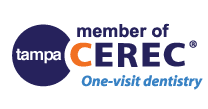
Technological advances are revolutionizing the practice of dentistry.
Drs. Evan Murrell and Dr. Victoria Jones take great pride in selecting those technologies that provide the best value, quality of service and comfort for their patients. We are committed to keeping pace with these changes and would like to highlight some of these new technologies.
CEREC CAD-CAM CROWNS
Drs. Evan Murrell and Dr. Victoria Jones take great pride in selecting those technologies that provide the best value, quality of service and comfort for their patients. We are committed to keeping pace with these changes and would like to highlight some of these new technologies.
CEREC CAD-CAM CROWNS
 One of our most exciting technologies is our Cerec CAD-CAM system. This technology allows us to make your new crown right here in the office while you wait. This means no temporary crown and no second visit!
One of our most exciting technologies is our Cerec CAD-CAM system. This technology allows us to make your new crown right here in the office while you wait. This means no temporary crown and no second visit!
Instead of taking a traditional messy impression, we scan your tooth using a digital scanner. The image is saved in a computer and the crown is then designed right before your eyes. The crown design is then sent to a milling machine and a new crown is made out of a solid block of porcelain in 20-30 minutes. Once milled and polished, the crown is then bonded in place and you leave with your brand new crown! On occasion, we will still need to send your crown to the lab to be fabricated but most can be made right in our office.
3D PRINTER
 Our newest technology is our Einstein 3D printer. With this new 3D printer, we can now fabricate different appliances such as nightguards, temporary partial dentures and temporary Maryland Bridges in a matter of 1 or 2 days, much faster than if we had to send it to a lab.. This is particularly important if you have just lost a tooth and want it replaced as soon as possible.
Our newest technology is our Einstein 3D printer. With this new 3D printer, we can now fabricate different appliances such as nightguards, temporary partial dentures and temporary Maryland Bridges in a matter of 1 or 2 days, much faster than if we had to send it to a lab.. This is particularly important if you have just lost a tooth and want it replaced as soon as possible.
SOFT TISSUE LASER
 Our diode laser allows us to perform various soft tissue surgical procedures in the most comfortable manner possible and allows for more rapid healing. Procedures include recontouring of gum tissue to provide a more pleasing smile, removal of gum tissue to allow the placement of a deep filling and the treatment of apthous ulcers (canker sores). The laser cannot be used to remove decay for the placement of fillings.
Our diode laser allows us to perform various soft tissue surgical procedures in the most comfortable manner possible and allows for more rapid healing. Procedures include recontouring of gum tissue to provide a more pleasing smile, removal of gum tissue to allow the placement of a deep filling and the treatment of apthous ulcers (canker sores). The laser cannot be used to remove decay for the placement of fillings.
COMPUTERS
 Common place now in dental offices but we were one of the first offices to have computers in all of the doctor and hygiene treatment rooms. Having this technology allows us to have, at our fingertips, a tremendous amount of pertinent information regarding your past treatment and current treatment plan. With a few clicks we can change or update your treatment plan, check your insurance coverage, find out when your next appointment is or even make you a new one.
Common place now in dental offices but we were one of the first offices to have computers in all of the doctor and hygiene treatment rooms. Having this technology allows us to have, at our fingertips, a tremendous amount of pertinent information regarding your past treatment and current treatment plan. With a few clicks we can change or update your treatment plan, check your insurance coverage, find out when your next appointment is or even make you a new one.DIGITAL CAMERA
 One of the most useful new technologies we have incorporated into our practice is digital photography. Using a digital camera, we can display, almost instantaneously, photos of you and your teeth and store these records on our computers. Each day, we seem to find additional uses for this camera.
One of the most useful new technologies we have incorporated into our practice is digital photography. Using a digital camera, we can display, almost instantaneously, photos of you and your teeth and store these records on our computers. Each day, we seem to find additional uses for this camera.Some of the things we can do with this technology are:
* Document the condition of your teeth and gums.
* Evaluate your existing smile and design corrections and enhancements.
* Have at our fingertips a photo of you so that we can put a face to a name.
* Document lesions or conditions that may be of concern so that we can determine if anything has changed.
* Take photos of your teeth and e-mail them to the dental lab so that we can match the shade of a new crown to your existing teeth.
* E-mail photos of conditions or lesions to specialists so that we can discuss your case or condition.
AIR ABRASION
 Air abrasion is a technology that allows "needle-free" dentistry. An air abrasion unit is like a mini-sand blaster. It utilizes a special abrasive powder, under high pressure, to literally "blast" decay away; generally with no more sensation than that of having air blown on the tooth. No local anesthesia is necessary. Unfortunately, it cannot be used in all cases. It can only be used on small cavities on the tops and sides of the teeth. By catching cavities while they are small, we can utilize this technology and eliminate the unpleasantness of local anesthesia.
Air abrasion is a technology that allows "needle-free" dentistry. An air abrasion unit is like a mini-sand blaster. It utilizes a special abrasive powder, under high pressure, to literally "blast" decay away; generally with no more sensation than that of having air blown on the tooth. No local anesthesia is necessary. Unfortunately, it cannot be used in all cases. It can only be used on small cavities on the tops and sides of the teeth. By catching cavities while they are small, we can utilize this technology and eliminate the unpleasantness of local anesthesia. "THE WAND" COMPUTER CONTROLLED ANESTHESIA DELIVERY SYSTEM
"THE WAND" COMPUTER CONTROLLED ANESTHESIA DELIVERY SYSTEMWhen local anesthesia is necessary, we have a device that helps to make this a more pleasant experience. "The Wand" is a computer-controlled anesthetic delivery system. By utilizing this system we can deliver local anesthesia in a much more controlled and generally more comfortable manner. Administering anesthesia slowly is the secret to giving it comfortably and 'The Wand" can dispense the anesthesia literally one drop at a time. "The Wand" also opens up the possibility of new types of injections that will often allow us to anesthetize only a single tooth. The beauty of this is that the tooth is numb, but you do not have that sensation of having a fat lip or tongue. "The Wand" can be used in most, but not all situations where we need to administer local anesthesia.
DIGITAL RADIOGRAPHY
 We are proud to say that we are now exclusively using Digital Radiography for both our regular x-rays as well as our Panoramic x-rays. Instead of using a traditional x-ray film, we use a special sensor that will transmit the image directly into the computer. This image can then be enlarged, enhanced or even colorized to allow for better diagnosis. We will still use x-rays to create the image but at doses up to 50% less than was previously required. One advantage of this technology is that we can now share an exact duplicate of your x-ray with specialists with only a few clicks of the mouse.
We are proud to say that we are now exclusively using Digital Radiography for both our regular x-rays as well as our Panoramic x-rays. Instead of using a traditional x-ray film, we use a special sensor that will transmit the image directly into the computer. This image can then be enlarged, enhanced or even colorized to allow for better diagnosis. We will still use x-rays to create the image but at doses up to 50% less than was previously required. One advantage of this technology is that we can now share an exact duplicate of your x-ray with specialists with only a few clicks of the mouse.





